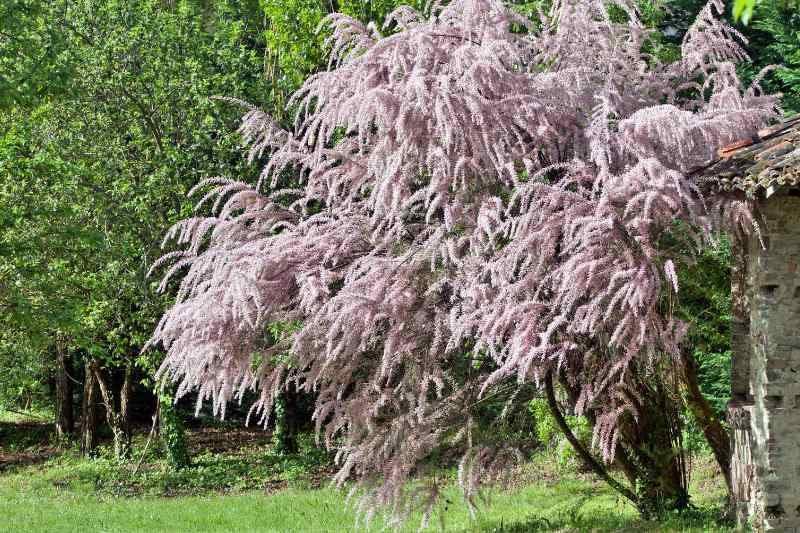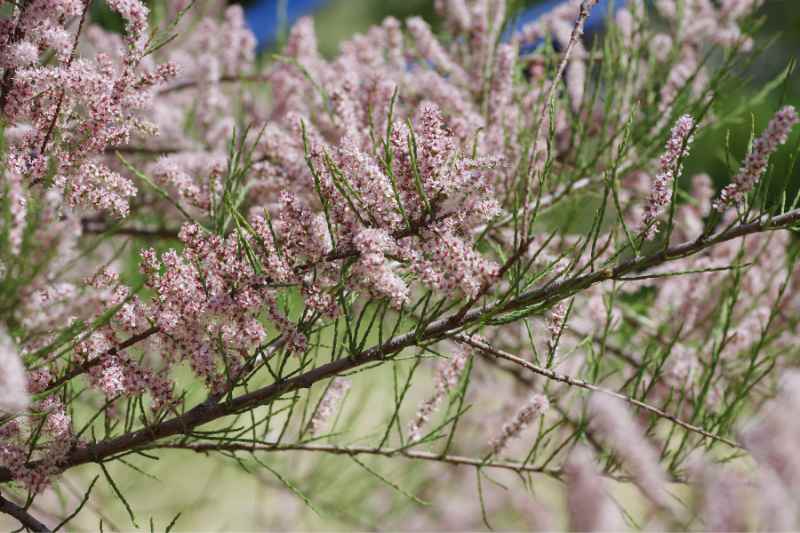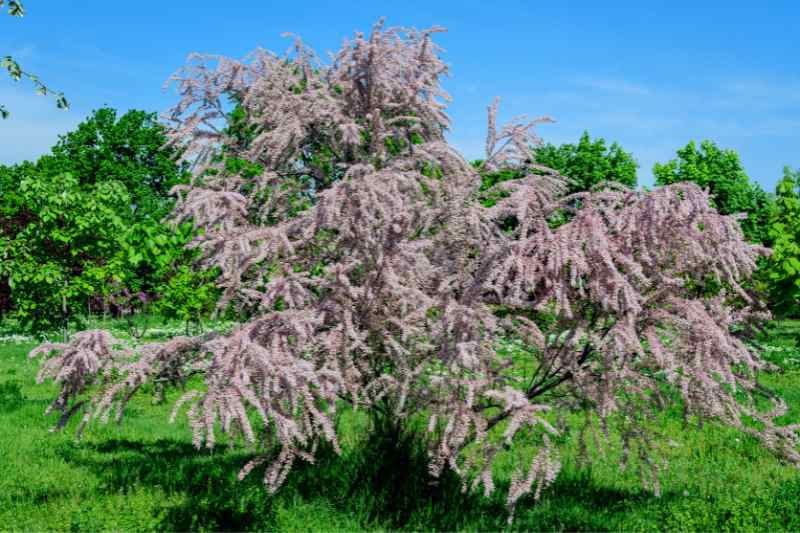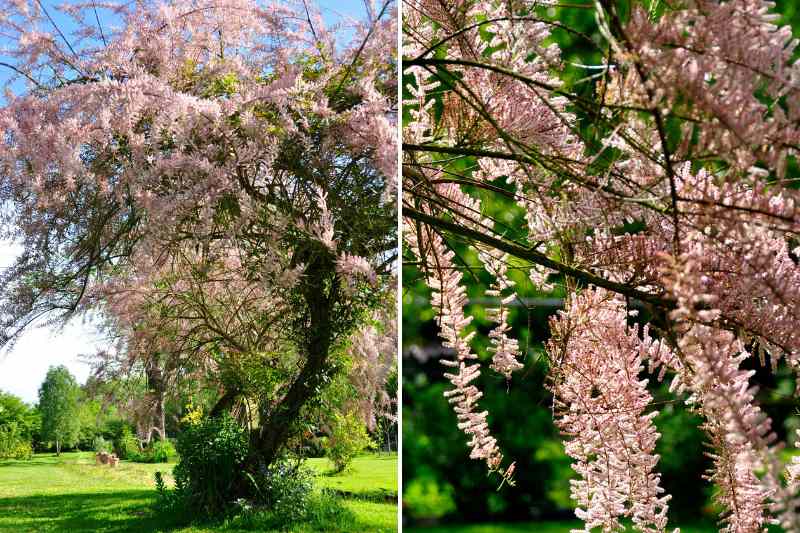Tamarisk or Tamarix, often known for its graceful, airy flowering, is adapted to a wide range of climates and can withstand strong winds as well as saline soils. It is therefore particularly valued in coastal areas, but it also finds a place in various types of gardens. Although this bush requires little maintenance, pruning helps tamarisk retain a harmonious habit and abundant flowering. Let’s discover how to prune spring tamarisk and summer tamarisk.
For everything on tamarisk, read Tamarisk: planting, pruning and care.

Some words about tamarix
Most common species in landscaping here are Tamarix tetranda, generally called spring tamarisk (April–May), and Tamarix ramosissima, known as summer tamarisk (August–September), referring to their respective flowering periods.
These plants are characterised by their small, scaly leaves of blue-green colour, which give the whole plant a fine, feathery texture. The flowers, tiny and grouped in dense clusters, range from white to deep pink depending on species and variety. The habit of these bushes is upright yet flexible, and can reach heights ranging from 1 to 5 metres, or even more for some species.
When to prune tamarisk?
For spring tamarisk (Tamarix tetranda), pruning should be carried out immediately after flowering, in early summer. This practice helps stimulate the plant to produce new flower buds the following year, while giving it enough time to strengthen before winter arrives.
By contrast, for summer tamarisk (Tamarix ramosissima), which flowers in late summer, pruning is recommended in late winter or early spring, before new buds begin to burst. This timing allows the plant to be cleared of any damage caused by winter cold and encourages vigorous growth and abundant flowering during summer.
Since tamarisks flower on previous year’s wood, pruning too late can remove flower buds.
Important: Pruning a tamarisk during a frost or in extremely low temperatures can expose the plant to further damage. Ideally, pruning should be done in mild weather, when the risk of frost is low and the plant is in a phase of relative dormancy or just before spring awakening.

Equipment needed
- Pruning shears : Ideal for cutting small branches and fine shoots. Make sure blades are well sharpened to ensure a clean, precise cut.
- Loppers : Necessary for thicker branches, generally up to 5 cm diameter. Their long handles provide better leverage, making it easier to prune branches without too much physical effort.
- Pruning saws: Used for even larger branches and cuts that require more precision. A curved-blade saw is particularly effective for working in confined spaces within the foliage.
- Gardening gloves: Essential to protect hands from scrapes and potential cuts when handling branches.
- Safety goggles: Recommended to prevent wood or sap particles from getting into the eyes, especially when working under the plant.
Pruning techniques
Formative pruning of a young tamarisk
- Observe natural shape of your young tamarisk and identify main branches that will form the basic structure of the tree.
- Remove low branches to raise the crown and make later maintenance tasks such as mowing beneath the tree easier.
- Remove small inward-growing branches to open up centre of the tree. This improves air circulation and light exposure, reducing disease risk.
- Prune branch tips to encourage denser, bushier growth, always cutting just above a bud facing outwards.
- If desired and feasible, you can reduce tree height to keep it manageable, cutting long branches at a point where a smaller side branch continues to grow outwards.

Maintenance pruning of mature tamarisks
For mature tamarisks, maintenance pruning aims to preserve tree shape and stimulate flowering:
- Removal of dead or diseased wood: start by cutting away any dead, diseased or damaged branches to keep the plant healthy.
- Rejuvenation pruning: every 3 to 5 years, carry out rejuvenation pruning by cutting up to one third of the older branches to stimulate growth of new shoots. Warning! Drastically reducing the canopy of a tamarisk can stress the plant, limit its ability to photosynthesise and reduce its flowering. Do not remove more than one third of the canopy during a single pruning session.
- Shaping pruning: lightly prune outer branches to maintain desired shape. Avoid cutting too severely so as not to stress the tree.
- Flowering management: since flowering occurs on last year’s wood, minimise pruning of branches that bear flower buds, unless they are obstructive or poorly placed.
Good to know: when you identify diseased parts of the plant, cut them out immediately to prevent spread of disease. Make sure to disinfect your tools after each cut to avoid contaminating other parts of the plant.

Aftercare
For large cuts on bigger branches, apply a tree wound sealant to protect wounds against infection and insects. This helps speed healing and prevent disease.
After pruning, the tamarisk may need a little more water than usual to aid healing and the growth of new shoots. Water deeply but not too frequently, allowing the soil to dry out slightly between waterings. This encourages roots to develop deeply, which strengthens the plant’s resilience.
Check and adjust mulching around base of your tamarisk. Good mulching helps maintain soil moisture, prevents adventive growth and offers thermal protection to the roots. Make sure mulch does not touch the trunk directly to avoid excessive moisture and risk of trunk rot.
































Comments